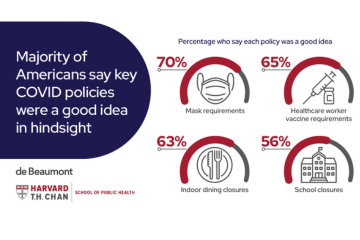
As health departments come to terms with the emotional and psychological impact of the pandemic, now is a critical time to recognize the many ways trauma can affect lives. Long before the pandemic, employees have brought their own personal histories to work, which may include trauma and childhood adversity. To meaningfully support their staff and the communities they serve, health department leaders should recognize how trauma can affect people’s brains and bodies and begin implementing practices that promote healing, well-being, and resilience.
Understanding Trauma
Trauma results from an event, series of events, or set of circumstances experienced by an individual as physically or emotionally harmful, overwhelming our ability to cope. Trauma can impact functioning across various domains, including physical health, emotional health, and learning. The physical and mental health effects of trauma, from chronic illness to anxiety, can take a toll on people across the life span.
A wide range of experiences can be traumatic. These include interpersonal experiences such as abuse, neglect, parental substance abuse, and witnessing intimate partner violence, as well as structural ones such as community violence, racism, and poverty. In addition, employees may experience secondary or vicarious trauma, which comes from working with others who experience trauma.
Childhood adversity and trauma are linked to systems of oppression and racism. Anti-racist work and trauma-informed transformation go hand in hand, and health departments cannot become trauma-informed without a commitment to racial justice.
Health Departments as Trauma-Informed Organizations
Trauma is not endured in isolation. In the workplace, trauma is associated with increased health care and workers’ compensation costs; increased employee turnover, tardiness, and absenteeism; and decreased employee presenteeism.1 These repercussions then spill over into local communities that are dealing with their own histories of trauma.
For health departments to effect change on a broad level, they must first look inward at how their policies and practices contribute to a trauma-informed environment. Building a trauma-informed organization begins with a shift in knowledge, perspectives, attitudes, and skills. Instead of asking someone, “What is wrong with you?” a trauma-informed approach reframes the question to ask, “What happened to you?” From there, the conversation turns to “What is right with you, what matters to you, and what can we accomplish together?”
Recommendations
With the following recommendations, public health leaders can build the foundation for trauma-informed transformation within their organizations:
Get buy-in across the board.
To bring about systemic change, get buy-in from senior leadership and all staff members at the outset. This can be accomplished by forming a working group that draws from a diverse range of departments, engaging individuals throughout the agency. All members of the organization should be trained in what it means to be trauma-informed—not just staff who are involved in direct services or behavioral health. Training all staff members underscores the collective responsibility to understand how trauma impacts the organization.
Assess the built environment.
The physical environment of a workplace influences people’s feelings of safety. As part of its work toward trauma-informed organizational change, the Chicago Department of Public Health conducted a scan of all its buildings to determine how they contributed to a safe, supportive physical environment. Consider the setup of spaces such as offices or waiting rooms; something as innocuous as placing chairs with their backs to the door could be triggering for people depending on their personal history of trauma.
Create a culture of emotional safety.
A trauma-informed organization is one where people feel comfortable and safe expressing their emotions and being themselves. In this environment, employees are not stigmatized for disclosing that they need space or time to themselves or that their work is weighing on them. As more employees work in virtual settings, taking the time to check in over video and phone calls can be helpful in forging connectedness. Equipping supervisors with the skills and best practices to promote safety is also critical.
Staff also may want to participate in discussion groups on mindfulness and meditation to incorporate these practices into the workflow and help employees with self-regulation. Less formally, starting meetings with a moment of quiet reflection is another way to help staff feel calm.
Assess human resources policies.
Organizations should ensure that policies promoting well-being and preventing burnout are being put into action. This includes policies from access to employee assistance programs to clear avenues to provide feedback without fear of retribution, as well polices that support a diverse and inclusive environment and ensuring that employees have a voice in their work.
Supervisory practices should also be evaluated to determine whether senior leaders and managers are creating safe environments and implementing policies in a consistent manner.
Engage the community.
Using trauma-informed practices with clients and the community promotes healing and thriving for all. Health departments should include community members in their planning processes, act with transparency, promote empowerment and peer support, and use trauma-specific interventions as appropriate.
Join a collaborative.
Trauma-informed organizational transformation is easier with the help of partners. Joining a collaborative of like-minded organizations can connect a health department to a wider network of resources and support. Through the Illinois ACEs Response Collaborative, health departments in Illinois have used focus groups to tailor training programs, lead community engagement initiatives, and discuss funding strategies.
The following resources offer more information for organizations working toward trauma-informed transformation:
- Substance Abuse and Mental Health Services Administration (SAMHSA)
- Mobilizing Action for Resilient Communities (MARC)
- Trauma-Informed Care Implementation Resource Center
- Illinois ACEs Response Collaborative
Reference
1. Anda RF, Fleisher VI, Felitti VJ, et al. Childhood abuse, household dysfunction, and indicators of impaired adult worker performance. Perm J. 2004;8(1):30–38.
This column first appeared in the May/June 2021 issue of the Journal of Public Health Management & Practice. See the final authenticated version.




